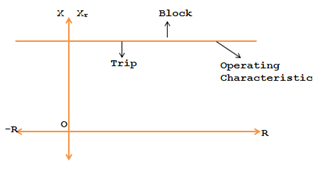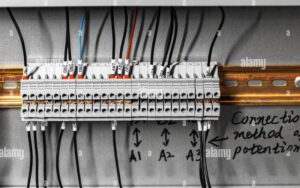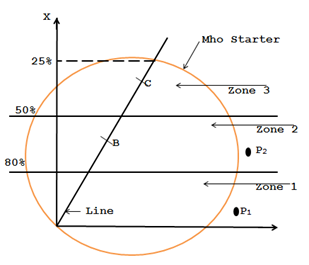
How an induction type reactance relay works

Fundamental principles
Induction reactance relays are designed to respond to specific operating variables in a power system, usually current or voltage. They are based on the interaction between magnetic fields and electric currents and use the phenomenon of electromagnetic induction. This interaction creates torques that determine the relay's response.
Structural configuration
In a simplified configuration called “induction cup”, the relay consists of top, bottom and right poles. The primary winding is normally connected to the circuit while the secondary winding, closed by a phase shift stroke, is positioned on the right pole. This secondary winding introduces a phase shift, causing the flux in the right pole to be out of phase with the change in the upper and lower bars.
Operating torque generation
The phase difference between the magnetic fluxes is the key to the operation of the relay. When current flows through the primary winding, it creates magnetic fluxes at all poles. The interaction between the right pole flux and the bias flux results in an operating torque called K1I^2, where I represents the current flowing through the primary winding. This torque serves as the driving force for the relay reaction.
Retention mechanism
Although operating torque initiates the relay's response to a fault or abnormal condition, a holding mechanism provides stability during normal operation. The interaction between the left pole and the polarizing flux creates a restraining torque. This torque neutralizes the operating torque and prevents unnecessary tripping when operating within acceptable parameters.
Phase angle adjustment
To adapt the relay response to specific protection requirements, a phase angle adjustment circuit is introduced. This circuit is connected in series with the voltage coil and allows adjustments to the sensitivity and response characteristics of the relay. By changing the phase angle, the relay's behavior can be adjusted to detect faults while accurately minimizing false trips.
RX diagram of an induction type reactance relay

As the value of K 3 is very small, it can be neglected.
Functionality and application of reactance relays

The reactance relay is activated when the measured reactance value is less than the specified or intended K value.
The driving unit used with the reactance relay is not the same as that used with the impedance relay because the reactance relay trips under normal load conditions when the power factor of the load is equal to 1 or close to zero. This is because the reactive volt-amperes limit at or near UPF is close to zero. So we need to have a steering unit called Mho Unit or Mho Relay with circular characteristics.
Reactance relays also protect short line fault currents less than 20 kA. With such cables, the effect of fault resistance or arc resistance predominates.
Understanding Axes
The 2R-X graph has two main axes: The horizontal axis represents the real part of the impedance (R) while the vertical axis is the reactive part of the impedance (X) . Each point on the diagram corresponds to a specific combination of resistance and reactance in the system.
Relay zone and properties
In the 2R-X diagram, relay operation is divided into zones corresponding to different faults and operating conditions. These zones help classify the relay's behavior and understand how it reacts to different situations:
- This is the area where the relay will activate in the event of a fault. It is defined by the relay settings and properties. If the impedance of the faulty circuit is within this range, the relay initiates a protective action.
- This zone represents the area where the relay does not work. Impedance values in this zone are normally outside the relay sensitivity settings. It ensures that the relay remains stable and does not trip under normal operating conditions.
Application and analysis
Engineers use the 2R-X chart to analyze the relay's response to various fault conditions. By plotting the impedance of the faulty circuit on the diagram, they can determine whether the relay will trip or remain inactive. This analysis helps to properly set the relay parameters for the desired level of protection and selectivity.
Considerations
- Coordination: The 2R-X diagram is crucial for coordinating relays within a network. Ensures that the relays closest to the fault operate, while the furthest relays remain inactive.
- Error Analysis: The diagram allows engineers to examine fault conditions and identify potential problems in the network that could affect relay performance.
- System changes: As the network configuration changes, the 2R-X diagram may need to be adjusted to reflect new conditions and maintain proper protection coordination.
Reactance relay with MHO starter
To protect the first, second and third zones of the transmission line, reactance relays such as those for 1st and 2nd Zones are used. The steering unit, an MHO Starter Relay, functions as a 3 Approximately Zone Protection Relay.

The directional unit used with the reactance relay, that is, the MHO starter, has a circular characteristic for the reason explained below:
High power factor loads
Under normal conditions with high power factor loads, the reactance measured by the relay may fall below the set value. This situation can lead to a false trigger if the appropriate response is not given.
Zone segmentation
To ensure that the relay operates accurately and selectively, its operation must be monitored. This is achieved by limiting the relay range in the RX (Reactance-Resistance) diagram.
General monitoring and 3rd zone
Under normal conditions, with high power factor load, the reactance measured by the relay may be lower than its setting. P1 and P2 in the diagram are in zones 1 and 2, respectively. To avoid false trips in these conditions, the reactance relay must be monitored by a fault detection unit (starter unit or starter), which limits its range in the RX diagram. Therefore, its characteristic should be circular. The forming unit detects errors and also serves as a 3 Approximate Zone Unit.
Understand the need for precision
High power factor loads are common in power systems. However, these loads can distort a relay's reactance measurements, potentially leading to false trips. The reactance relay, which is intended to respond to certain impedance levels, may trigger inaccurate protection measures in such scenarios.
Benefits
The combination of reactance relay and MHO starter offers notable advantages:
- Avoiding false trips: The MHO starter guarantees system stability and avoids unwanted disturbances, avoiding false relay trips due to the high power factor.
- Uniform protection: The MHO circular starter takes into account reactive and resistive elements, ensuring consistent protection across a spectrum of fault conditions. This feature improves the overall reliability of error detection.
- Extended Coverage: The MHO starter not only eliminates false trips, but is also a third zone unit. This extended protective coverage adds an additional layer of security to the power grid.
Conclusion
At the end of our journey through the fascinating world of induction reactance relays, we find ourselves at the interface between tradition and innovation, where the elegance of electromagnetic principles meets cutting-edge technology. These relays, which act as guardians of stability in electrical networks, illustrate the harmonious synergy between scientific theory and practical application.

